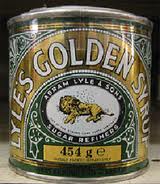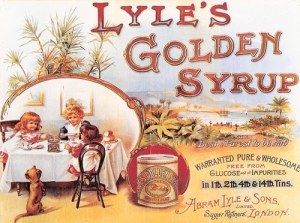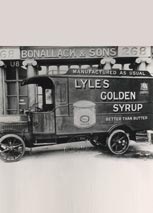Can there be anything else that sums up British baking as much as Lyle’s Golden Syrup? If you are not British then you might not have heard of it and it is rather difficult to compare it to anything else. It looks like honey, but is viscous like a syrup such as corn syrup and yet it tastes like neither. The taste is more like butterscotch or caramel. It is also commonly called treacle. I absolutely love the stuff and manage to get hold of it here in Missouri to go on my porridge or pancakes of a morning. Oddly, it was never intended to be a commercial product, but thank goodness it became one. I remember as a child, my Dad always used to make us a treacle sandwich after our Sunday baths whilst we dried in front of the fire, soggy towels wrapped around us.
The story of golden syrup starts in 1881when the Scottish businessman Abram Lyle set up a sugar-refinery in London on the Thames with his five sons, processing sugar cane into sugar loaves. In those days, sugar was bought in large tapering mounds that had to be pounded or grated by hand at home. One byproduct of the process was a thick, gloopy syrup that with a little more refining through charcoal was very delicious. So he sold it to his workers from large barrels (Lyle was originally a cooper) and the syrup quickly was anointed with the nickname “Goldy”. Soon, Goldy became popular outside of his workforce and everyone wanted some. Just two years later, in 1883, Lyle’s Golden Syrup was born.
It is the tin the golden syrup that comes in that is the icon of both British cookery and Victorian entrepreneurship. Famously, on the front is a drawing of a dead lion peppered with swarming bees. Abram Lyle was a very pious man, and used the story of Samson in the book of Judges in Old Testament as the inspiration for the design. Quite a while before his fateful haircut, Samson got attacked by a lion which, through His power, Samson was able to rip open, killing it. Later he sees that bees have built a hive within its carcass and he takes some honey to his family and friends and they have a feast. He didn’t tell them about the lion and had them guess how he came about all the honey, presenting them with the poser:
And he said unto them, Out of the eater came forth meat, and out of the strong came forth sweetness. And they could not in three days expound the riddle.
Judges 14:14
If you like the blogs and podcast I produce, please consider treating me to a virtual coffee or pint, or even a £3 monthly subscription: follow this post for more information.
Tins were first produced in 1884 and unbelievably have not changed at all in their design since. In fact, the recipe for the syrup has never changed either – making Lyle’s Golden Syrup the oldest brand in the world. “You’d be mad to mess with Goldie.” The only slight change is to the weights written on the tin: gone are the “1 lb” and “2 lb” marks, their replacement being the “454 g” and “907 g” marks, to keep in line with EU rulings. Another change occurred during the Second World War when, because of tin shortages, Lyle had to make the ‘tins’ from cardboard instead.
For over 125 years, it has been indispensable – it was even taken on Captain Scott’s fateful trek to the Antarctic. He wrote a letter to the Lyle family:
“Your Golden Syrup has been in daily use in this hut throughout the winter, and has been much appreciated by all members of the expedition.”
In 1950, the Lyle Company brought out a second iconic product: Lyle’s Black Treacle. It is very similar to molasses, though it is considerably thicker and stronger tasting. For any recipes that ask for black treacle, you can substitute molasses instead with no problems.
In the American classic The Fannie Farmer Cookbook, there is a recipe for Cornish Treacle Tart (which is actually made from Golden Syrup). In that recipe it asks for three-quarters of a cup of dark corn syrup. Do not on no account ever, ever, substitute golden syrup for corn syrup. The two are incomparable. So, I urge the American public: if you use a recipe that asks for Golden Syrup and you cannot get hold of any, don’t bother making it. Do you hear me? Good, then we understand each other. Amazon’s grocery section stocks it, so you can always get it online.
Lyle’s Golden Syrup and Black Treacle are part of so many wonderful recipes, I would be crazy listing them all, but here are what I reckon are the important or interesting ones. As I add recipes, I’ll add links. If you know of any that I have missed off, please let me know. Here goes:
Flapjacks
Treacle sponge pudding
Mrs Beeton’s rolled treacle pudding
Golden syrup cake
Aunt Nelly’s pudding
Malt loaf
Jamaican ginger cake
Ma Buttery’s crunch
Bonfire toffee







Are the recipes for these dishes listed somewhere else? They all sound remarkable. Do your recipes have American measures or only UK? I must run to buy some Golden syrup now!
LikeLike
Some of the recipes are on here (I have turned the ones on the blog into hyperlinks though they are not obvious… I intend to try and cook them all eventually!
LikeLike
Ah! Treacle on bread! When I was a street urchin back during the war these were a staple. Our baker made bread in double tins so on every loaf one end was a hard crust and the other was a soft crust. This end slathered with treacle (lyle’s golden syrup) made gods of us. We ate them in the street. The bliss was to get layers of sticky syrup on the upper lip as high as possible and then try to lick it off.
I think the absence of treacle in the US might be due to the fact that there were already rivers of maple syrup in New England and, while it doesn’t have the defining stickiness of treacle is an equally tempting adornment for pancakes, and we know how easily tastes are acquired.
You may not want to know this but I’ve seen, even here in Spain, small bottles of Lyle’s Golden Syrup that are labelled ‘Maple Flavour’. It seems to me that it’s another case of taking two good things and making something that’s like neither. But suppose it has its uses.
On the subject of the states of New England, I consider myself deprived not to have been raised in any one of them. If anywhere has it all, baking included, that’s where it is.
I’m going to write a song now called ‘I Left my Heart in Manchester, MA’
Cheers.
LikeLike
You have a point om the maple syrup front there, Eric, and I have to say I love it too, but I cant imaigine something like a treacle sponge or some oaty flapjacks being the same with the strong-tasting and much less viscous maple syrup. For pancakes, though, it is great and I am sure I shall be adorning mine on Shrove Tuesday with both…
LikeLike
I use Golden Syrup all the time. Usually, if a recipe calls for corn syrup I’ll use golden syrup instead, but never the other way around! Lyle’s is so much yummier than Karo.
I’m able to get it from World Market, but Black Treacle is another story all together. I’ll probably have to order it online when my tin runs out.
LikeLike
That’s a good idea! I actually cant eat corn syrup because I am slightly fructose intolerant. Golden syrup contains inverted sugars and isn’t so bad – from now on, I shall swap corn syrup for golden syrup.
I use proper black treacle if there is a large amount required of it in a recipe because of the consistency it provides, othwise I just use molasses
LikeLike
The stuff in the bottle isn’t the same at all – much thinner and not a substitute in baking. The only place for it is left behind on the supermarket shelf until they stop making it. The synthetic maple flavoured kind is just horrible – husband brought it home one day when he couldn’t find the real thing – can’t remember what we did with it after the first taste – probably the bin.
On the omissions front – your basic ginger biscuit with lots and lots of ginger and crisp cracking top and of course brandy snaps.
And once upon a time in the Leeds area everyone’s granny made a biscuit that was somewhere between and ginger biscuit and a brandy snap – thin, crispy, the edges lacy. Aunt Ada was the manufacturer in our family, but I remember lots of houses where they were a Sunday tea standard. I’ve never found a recipe and they were never available for sale in bakeries – strictly a home made treat. I’ve played around with lots of recipes trying to recreate them. Does anyone remember them and know how to make them. Next best thing is brandy snap not rolled and with extra ginger but it isn’t quite right
LikeLike
I whole-heartedly agree on the squeezy bottle front!
I don’t remember those biscuits you describe – and I am from Leeds as well! I shall ask my family; my dad might know…
LikeLike
As an aside I’d like to say that here in Andalucia there’s a product called ‘Miel de Cana’ (‘Sugar Cane Honey’ aka cane syrup). Many visitors think it’s actually a type of honey but it’s a product of sugar refining as is Golden Syrup. Its distinctive taste is more caramelly and the difference to GS is something like that between brown bread and white. It’s wickedly moreish on a rich home-made ice cream but also great with steamed puds and as a baking ingredient. It exists here because the coast of Andalucia has until recently been an area where sugar-cane plantations have long been an important part of the economy. So ‘Miel de Cana’ is a pure local product – also used in the making of local rum . . . . Cheers.
LikeLike
I have heard about other cane syrups but couldn’t find any British ones – I’ve never tried any either. I shall have to try and get my hands on some.
Cheers, Eric
LikeLike
Pingback: Pancake Day | British Food: A History
Pingback: The Treacle Mines of England | British Food: A History
Pingback: Treacle Tart | British Food: A History
Pingback: Curious food #3: Abram Lyle & Sons Black Treacle «
Don’t forget the Treacle Mines found in the north of England!
https://britishfoodhistory.wordpress.com/2012/04/01/the-treacle-mines-of-england/
LikeLike
Indeed! You’ve linked to my own post!!
LikeLike
Pingback: Sticky Learning and the Dumbing Down of Exams
Interestingly, at the height of the nonsense about European weights syrup was sold in taller tins which were clearly designed to hold 1kg. I never saw one for sale with more than 907 grams in it and they soon disappeared from the shelves.
LikeLike
Hey John. Thanks for the comment. Were these tins Lyle’s tins? If so, it’s odd they made a Euro tin and a British tin! As much as I love the old measures, it would make much more sense to change to 500 g and 1 kg tins!
LikeLike
Pingback: Golden Syrup Substitute That You Can Easily Find
Pingback: Apple Hat | British Food: A History
Pingback: The Sweet Details of Treacle, Britain's Favorite Syrup - Bookkeeping Services And Quality Tax, Accounting, Payroll Services- Oakland, CA
Porridge for breakfast with golden syrup the way my mum served it in the 1950s led to us finding your site after a dispute over whether the syrup tin depicted bees or flies. Thank you. I was right! And my mum was A Scot so she knew.
LikeLiked by 1 person
Well I’m very glad you found me, and of course you were right!
LikeLike
Yeah you asked if you missed any treacle recipes and I know in Scotland they used to love those treacle scones I guess treacle was cheaper all the rich people got the sugar and all the poor people got the treacle I’m assuming the treacle has all the vitamins and minerals in the sugar has nothing also you make barbecue sauce for me or you use it before your barbecue sauce.
LikeLike
Hi Daniel. Were the treacle scones made from golden syrup or black treacle? There’s some confusion with what is always meant by treacle – sometimes it can be both/either. But black treacle certainly has some vitamins and minerals in there, so you may be up to something.
LikeLike
Id love to know how Scot actually got the stuff out of the tin, i`ve accidentally put mine away in the fridge on occasions and its rock hard the next day never mind being in the Polar chill !
LikeLiked by 1 person
Haha. Good point! Maybe that was why it was left uneaten?
LikeLike